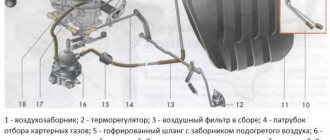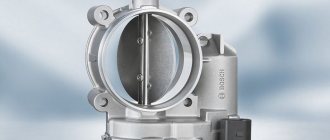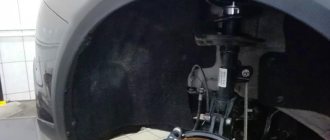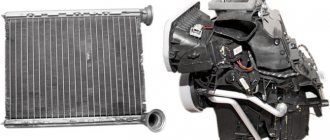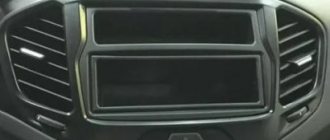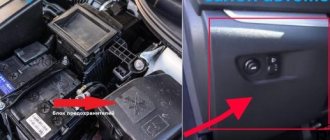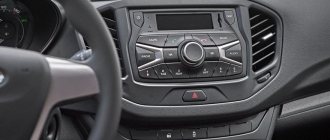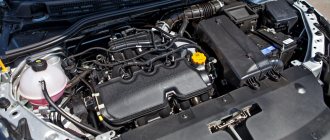Modification or adjustment of the electronic gas pedal (E-gas) on the Lada
E-GAS or electronic gas pedal is installed on all Lada models (XRAY, Vesta, Largus, Granta, Kalina, Priora and Niva 4x4). Owner reviews about it are not reassuring; many complain that the e-gas pedal is “dumb” (less sensitive and informative than a conventional cable). Did you know that in some cases the electronic accelerator pedal can be adjusted to be more responsive and a little livelier?
We determine the model of the accelerator pedal; this can be done by the catalog number, which is glued to the side of the body. If you cannot access the sticker, you will have to remove the electronic gas pedal:
- Disconnect the block with wires next to the gas pedal;
- Remove the housing and pedal assembly.
Unscrew three nuts using a “10” wrench;
The manufacturer installs at least two types of electronic gas pedals on Lada cars (depending on the year of manufacture):
- Old model (catalog number: 11183-1108500);
- New sample (article: 11183-1108500-01).
Each block is modified differently. Attention! You do all further actions at your own peril and risk. In addition, you may lose your warranty.
Reliable, but
New suit: what has changed in the popular Russian station wagon
Test drive of the updated Lada Largus Cross - new design, new options, new engine
The 1.8-liter VAZ-21179 engine was created for the Lada C, the predecessor of Vesta, which was developed jointly with the Canadian Magna, but never became serial. This is the first AvtoVAZ engine equipped with a variable valve timing system. Design features and the use of imported components were supposed to ensure reliability and service life in the region of 400 thousand km.
In reality, the result was increased oil consumption and “childhood” diseases. For example, the fuel hose of some cars rubbed against the wiring clamp, which could lead to a fire. In October last year, more than 90 thousand cars were recalled for this reason. Then the engine received a new cylinder head, the design of which made it possible to defeat the oil burner.
Meanwhile, the prospects for the engine are vague. During the first quarter of this year, the share of “West” with a 1.8 engine fell by half to 1,336 units, and the share of the 122-horsepower Xray dropped to 18.3%. Low demand may make the production of a Russian power unit unfeasible. The Xray model is also questionable. The CVT that the Xray Cross is equipped with cannot be installed on it; the car would have to be seriously redesigned, and the “robot” that recently appeared on the version with a 1.6 engine is a dubious replacement.
Motor - removed2
Engine of the LADA Niva Travel car
Photo: RIA Novosti/Alexey Danichev
Born wild: how the legendary Russian SUV has changed
Test drive of the new Lada Niva Travel
Adjusting old-style E-gas
The block cover (11183-1108500) is fixed with bolts that are inserted into oval holes. The improvement is this. to loosen the 4 screws and turn the cover in the desired direction:
- Economy mode (counterclockwise). To drive smoothly, to accelerate, you should press the pedal a little more than before. Gasoline consumption is reduced;
- Active mode (clockwise). The car reacts even with slight pressure on the gas pedal. Gasoline consumption increases. The pedal becomes more sensitive and informative.
In other words, we get the same effect as after installing JETTER (Jetter or spur).
It has been noticed that the first minutes after such settings, the idle speed may be increased (about 1300 rpm). But after a minute, the ECU gradually adjusted and the speed dropped to the usual level. If this does not happen, turn on the ignition for a minute and then start the engine.
If necessary, you can easily return to the original position (mark it in advance).
Refinement of a new electronic gas pedal
The pedal assembly (11183-1108500-01) does not have oval holes, which does not allow adjustment in the manner described above. Instead, it is proposed to cut off the protrusion (by 2-3 mm), which prevents the pedal from moving completely. This modernization made it possible to increase the pedal travel, which made acceleration with “pedal to the floor” more active. It is also noted that there is no hesitation when pressing the pedal sharply.
What I don’t like about the pedal assembly (8450008980), which is installed on Lada Vesta:
- tight gas pedal;
- large free play of the gas pedal (about 8 mm at the tip of the pedal).
What was decided to do:
- remove one of the return springs to make the pedal softer;
- Place a spacer to reduce the free play of the pedal.
How to measure pedal free play:
- Let's start the engine.
- Place a ruler at the tip of the pedal.
- Smoothly press the pedal until the engine begins to gain speed.
- We remember the distance on the ruler.
We remove and disassemble the electronic gas pedal:
- Disconnect the connector (by pressing the inside of the upper part of the latch)
- Unscrew three nuts (head “10”).
- Remove the top cover by unscrewing the fastening screws.
- Remove the rheostat slider by unscrewing the screw.
- Remove the spring (holding them with a screwdriver from the outside).
- Remove the white support spacers, remembering how they were installed.
- We measure the distance between the support pad of the return spring lever and the support rubber in the body, retracting the pedal to the amount of free play (indicated by an arrow).
- We glue the material of the same thickness (in this example we use 4 mm stickers for furniture legs and doors) using glue or double-sided tape.
We assemble the pedal assembly and install it in the car. The idle motion of the pedal should be minimal, about 1 mm. If the engine idle speed is higher than usual, and there is no free play of the pedal at all, then too much has been added. You will have to repeat the adjustment operation, adjusting the thickness of the lining. The same thing applies if the free play after adjustment remains more than 1-2 mm.
Malfunctions of the electronic gas pedal
Moving contacts and conductive paths are subject to wear, which makes their signals incorrect. As a result, the engine will operate unstably, “dips” will appear, and at idle the speed will “float”. If a malfunction occurs in the operation of E-gas, the Check Engine warning lamp on the instrument panel will light up, and the ECU will switch the system to a reserve mode of operation, in which the speed will increase slowly, even when the gas pedal is pressed sharply. Fuel consumption may also increase.
If both sensors fail, the ECU will switch the engine management system to emergency operation mode, the engine will only operate at speeds slightly above idle (1500 min-1). In this case, it is recommended to contact a service station to replace the failed parts under warranty.
Light engine vibration at idle on Vesta: diagnosis of causes
Lada Vesta is equipped with one of two gasoline engines – 21129 (1.6 l.) or 21127 (1.8 l.). The control system is electronic. Initially, the operation of the computer and feedback sensors is finely tuned. However, over time, a problem arises - instability of speed at idle and while driving. Determining the exact cause is often difficult due to the fact that the Check Engine light does not light up, so scanning the ECU is useless. Still, you can identify the flaw of uncomfortable functioning on your own.
Poor hood seal
For the first year and a half, Vestas were fitted with a hood seal of two halves with a gap in the center near the lock. It was there that dirt broke through under the hood in huge quantities. Over 15–20 thousand km, the engine compartment becomes suitable for planting vegetables.
Later the plant switched to solid rubber. The trouble is that in the central part it is still not glued. The rate of contamination of the engine compartment has decreased, but has not become zero. Lovers of cleanliness still need to do “collective farm” work in every nook and cranny of the car. And not only them: Vesta is so dirty in this part that even checking the oil level is unpleasant.
- A wide range of auto chemicals and many useful car accessories can be found on the pages of the Za Rulem store.
Source
The theory of engine vibration at idle speed of Lada Vesta and possible causes
Theoretical aspects
The amount of air is regulated: the degree to which the gas pedal is pressed determines the opening angle of the throttle valve. Incorrect determination of the control system for the volume of the air mixture leads to the fact that the speed of the Lada Vesta floats at idle and while driving.
What causes the floating effect? The amount of gasoline sprayed into the manifold is calculated based on the volume of incoming air. When the computer perceives the latter incorrectly, the motor gains momentum. The degree of fuel injection remains the same, the mixture becomes leaner and the power plant begins to stall. The amount of oxygen and nitrogen mixture consumed is reduced, fuel consumption remains the same and is now sufficient - engine operation is stabilized. Then the cycle repeats.
Probable Causes
At this stage, it is clear that low-quality fuel can cause engine detonation, but not cause unstable idling. Untimely ignition of the fuel-air mixture can cause a negative effect. To eliminate the malfunction, a comprehensive inspection should be carried out:
- SU sensors.
- Regulator in the throttle assembly.
- Elements of the inlet assembly unit.
- Brake system units.
- Gasoline vapor recovery algorithm devices.
- Ignition systems.
Lada Vesta does not drive, its engine is weak - true or false
Many people say that the Lada Vesta has a weak engine. I partially agree with this, but not completely. There are always people who are “for” and “against”.
The first camp is those who think that the 1.6 liter engine is weak
. They are right - the engine that goes into the Lada Vesta is a motor from Priora. These are old developments; it was enough for the Priora. But the Lada Vesta is heavier, so it’s more difficult for the engine.
In my opinion, the engine is enough if you drive on 15 wheels, and there are a maximum of 2 people in the car. Ideally 1 driver. So Vesta feels more or less at ease. My winter wheels are size 15. When I put on 16-inch wheels in the summer, the car feels it, especially when accelerating sharply from a standstill.
Also, if 4 passengers get into the car, it feels like it’s not moving. Of course, if you always drive with such a load, this will seem normal to you. But I mostly drive alone in the car, and when passengers sit next to me, I feel it strongly.
The second camp is those who believe that the engine is enough
. How do they justify their opinion? The first nail is a budget car, this is a “B” class. But why can Solaris and Rio offer fast engines without the “Sport” prefix?
The second nail, the fattest and most telling, is that the car is not for racing. It’s hard to disagree, but the engine power reserve is your safety. When you are driving on the highway, whether you like it or not, you will have to overtake. And when you have power to spare, you are more likely to complete the maneuver on time.
Overall, the car is decent, the engine is good and reliable. It goes 150-200 km, and that’s already good. Considering that on average an ordinary car enthusiast drives from 10 to 20 thousand km per year. I understand why everyone needs an engine. According to statistics, Lada Vesta is bought by those over 35. When you no longer want to drive, just peace and quiet.
Lada Vesta gives these sensations. The noise insulation is decent; the engine is definitely enough for a quiet, measured ride. I think the Lada Vesta is an excellent car. This is evidenced not only by sales, but by the fact that people are upgrading their car to Lada Vesta.
There is such a thing as a customer brand loyalty index. It is considered the largest from Apple, because a client who once bought Apple buys only this brand. Most importantly, I recommend him to friends and acquaintances. Lada Vesta can be compared to Apple.
If you look at the Drive-2 statistics, many people use and exchange their Vesta for the same new one. They often have parents, children, or acquaintances who also buy Vesta and enjoy it. You have to be an adequate person. If your income has increased sharply and you can afford a Toyota, then you will buy a Toyota or BMW, Mercedes.
I’m not saying that Lada Vesta is better than premium brands, but it’s definitely no worse than Kia Rio, Solaris, Rapid, and even more so the Chinese. Unless, of course, you have problems with self-esteem, and it is important for you that there is a foreign car in your yard, and God forbid someone tells you that you did something wrong when you bought a Lada, or just a domestic car.
If you don’t have any prejudices or stereotypes, then Lada Vesta is a great option. If you have a problem with this, then it’s better to take Rio, Solaris or Rapid. Overpay a little, take out more credit - you are the happy owner of a foreign car.
Vesta is a luxurious car, this has been proven by time. Practice is the criterion of truth. Vesta has proven in practice over time that it can please and satisfy the needs of a modern car enthusiast with a budget of up to 1 million rubles.
Write which camp you belong to. I wish you all a great mood and good health!
Source
Route map for identifying causes
Incorrect determination by the computer of the volume of air supplied to the combustion chamber, problems with the ignition system and an additional flow of gasoline vapor into the intake manifold of the Lada Vesta cause engine vibration at idle speed and operating modes. There are many reasons, so diagnosis should be done progressively. Check:
- Presence of air leaks in the intake pipe.
- The operation of the vacuum brake booster and the integrity of the connection between the tube and the input manifold.
- Canister valve.
- Throttle position sensors, absolute pressure and temperature sensors, idle air control.
- Integrity of wires and serviceability of ignition system coils.
Mass air flow sensor or crankshaft position sensor
Failure of these sensors can also cause the engine to run rough. Incorrect data on the amount of air entering the engine leads to incorrect opening times of the injectors and, as a result, incorrect preparation of the fuel mixture. The crankshaft position sensor can also cause confusion, due to which the moment of opening the injectors and the formation of a spark in the spark plugs will be chosen incorrectly. Hence the uneven operation of the engine with dips when picking up speed. Diagnostics will help determine the faulty sensor. This sensor will have to be replaced.
Incorrect engine control unit calibration
In many cases, a malfunction of any sensor or the same ignition module will be indicated by the “Check Engine” icon on the instrument panel. But there are times when everything works normally and there are no malfunctions, but the engine still suffers from failures when gaining speed. This is due to incorrect calibration of the control unit. Moreover, such symptoms may not appear in all cases. And, for example, only in an unheated state. A striking example is the Lada Vesta Cross with a 1.8-liter engine that recently left our fleet. When cold, her engine suffered from slight stalls when revving up due to the fact that insufficient fuel was clearly entering the cylinders.
In this case, all that remains is to wait for the updated software of the control program, in which all errors will be corrected. As for other culprits of acceleration failures - apart from worn injectors and problems with the ignition module - as a rule, the reasons are not fatal. The main thing is not to delay eliminating them.
Expert comment:
The problem of failures during overclocking occurs regularly in our service practice. If we talk about the fuel system, the main cause of jerking is the pump. Productivity decreases due to mechanical wear and clogging of the receiver grid with fuel by-products. The most common transmission malfunction that causes jerking when driving is the automatic transmission and the Haldex clutch. Untimely replacement of technical fluids and incompetent maintenance cause operational failures. Symptoms are especially pronounced in hot weather. In turbocharged engines, the turbine may be the cause of jerking during acceleration. The weak point of the unit is the pressure control system: solenoid valve or electric drive. If after replacing the valve the problem usually goes away, then on electrically driven turbines the official repair technology is to replace the turbine. And this is completely different money.
Cross selling
Basically, the 1.8 engine was chosen by buyers of off-road versions of Cross. For example, in 2021, for 10,725 raised “Vests” there were only 882 regular and 451 “charged” Vesta Sport. During the same time, they bought 4,183 Xray Cross crossovers and only 311 regular Xrays. It is for this reason that AvtoVAZ decided to reduce the variety of its model range.
Cross versions have worse aerodynamics, larger 17-inch wheels, so they need the most powerful engine available. At the same time, the performance of the 1.8 engine is modest by modern standards: 122 hp. and 170 Nm of torque. In the forced version for Vesta Sport it was possible to achieve 145 hp. and 184 Nm of torque - the result is more civil than sporting. So the dynamic characteristics of cars with a 1.8 engine can be called acceptable, for lack of anything better.
Motor - removed 1
Crossover Lada Xray
Photo: TASS/Sergey Konkov
Dips when pressing the gas pedal
Date: November 30, 2021 9:26 am
Find a trusted chip tuning specialist in Moscow.
Contact ADACT partners in your city for chip tuning. We guarantee a 10-day test drive, money back and replacement if you don't like the firmware.
Car owners often notice that the car jerks when accelerating. Such dips mainly appear at low and medium speeds. They are characterized by the following:
- Failure from 2 to 9 seconds;
- With a jerk of 1–2 seconds;
- Jerking - a series of jerks;
- Rocking - a series of failures.
Few people like this kind of car behavior. If the car stalls when accelerating, you have to press the pedal harder, which increases fuel consumption. This is also a matter of safety for the driver and passengers. When overtaking, a quick reaction to the gas is required, but the car “thinks for a long time,” which is why you may not have time to complete the maneuver. With such thoughtfulness of the gas pedal, the ride becomes uncomfortable.
Lada Vesta failures during acceleration
I also encountered a problem with jerking. The situation is this: many people complain from the very beginning that the car does not move and there are jerks when changing gears. So, I didn’t have this from the very beginning, acceleration from the bottom, dynamics, gear shifting - everything is excellent. I really didn’t understand what people were talking about. Now the mileage is 8500 and I recently found out what it is and it’s really annoying. How it happened - I always noticed that when gasoline approaches the red zone, the car drives worse. I had to drive about 15-20 km on the light bulb, then I filled the tank full and the problem started. It could be a coincidence, of course. I've already driven off the gasoline, that's not the problem. The cravings also became worse. You press the gas, it stalls for 1-2 seconds, then it jerks. The question is: has anyone tried to combat this by replacing spark plugs and coils? I had a similar problem on my viburnum when one of the coils burned out. I’m not going to the officials yet, they’ll still say it’s normal. The essence of the question is that the car can drive normally if it was driving before, but many suffer from these jerks. Engine 1.8 manual, April release square ramp.
Hello! Start with spark plugs and rubber hoses of the V.C. gas system. and do a throttle adaptation! It should help.
On naturally aspirated gasoline engines, gear shifting starts at 2500 engine rpm if you drive 1500-2000 in 2,3, etc. the engine is under tension and jerks, diesel is different and has more torque
Hi all! Yesterday I went to the dealer about the car jerking and poor acceleration dynamics, maybe I think the ramp will be replaced under warranty, especially since my car is subject to a ramp replacement. And after diagnosing the car, it was politely sent to hell...! They said: there are no errors, crappy gas, look for a good gas station and charged 500₽ for diagnostics. This is fine?
Ilya, maybe they said something about gasoline, they weren’t lying. Somehow I thought about it, thought about it, and came to the conclusion that, yes, gasoline and its quality are important. Somehow it took about three months to fill up with gasoline at Bashneft. It was great for two months, and then, no matter how it doesn’t go, it jerks. It was a mess for a month. The impression is that a lot of air is being supplied to the system. There’s a guy at work, also a designer, he just has a Vesta station wagon, he refueled there too, that’s what happened too. Then I saw that he lives near a gas station, they closed it there and let’s clean all the tanks, they rarely did this. The guy switched to another gas station and was glad. I burned almost all the fuel, refueled at another gas station, 92, as if the saints had flown over the house. Then I filled it with 95 and the car completely flew off.
I went to one with the same problem. At first they said that I simply did not know how to use the clutch. Then they claimed that it was impossible to rev above 3000 rpm. Then they said it was a matter of gasoline. After I countered all their arguments, the warranty engineer remembered that there were no errors. Well, I got an answer to that)). Errors only occur when there is a misfire, and this is only one of many symptoms and its presence is not necessary. After that, they agreed to send an application to the plant. On September 10, they said that the plant had approved the replacement and still nothing.
Greetings! 1.8 manual transmission. After 1,500 km, a humming noise appeared when moving backwards (neutral or gear does not matter). Moreover, the longer it stood, the stronger the hum; it disappeared after 2-4 seconds and did not always appear. I'll try to take a video today if possible. I have not found a similar phenomenon in anyone. In a week I’ll go to TO-0, and I’ll present it there!
Hello everyone. Finally, I solved the problem with twitching and failures of 1.2 and it happened on the third! I have a cross 1.8 manual transmission with a mileage of 25,000 thousand. For a long time I was looking for how to solve this problem, I went to all the diagnostics in my city, the dealer in my city said this is the norm, so I gave up on it, so So I started looking in electronics first, everything was fine! In mechanical components, everything is fine! I checked the ECU probably 6 times, went to all different firmware specialists, went to no avail, spark plugs, throttle valve adaptation, tried everything and all to no avail! Well, I think I'm fucked up, I decided to sell the cross. I took my car for maintenance and after a while the manager calls me and says, are you comfortable driving the car? I say "No! I’ll sell it all twitching and spitting, and here he is, we can solve this problem by flashing the ECU, I tell him that I’ve done the flashing 6 times and all the different specialists are of no use! And he tells me we don’t know how to flash, and we order a program from Moscow, but I think let’s try. I’m on my way to pick up the car, at the service center they tell me to take it for a ride, and I was just like, oh, I just drove it all day and all night! The car is completely different! The dips, all sorts of spitting and the like disappeared, the car was just fire and traction appeared! So why am I all this, it’s all about the firmware, get the firmware done by trusted specialists! And by the way, my ramp is ROUND! And my catalyst has been removed. And now I'm happy with the car! All the best
